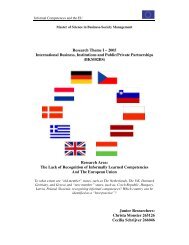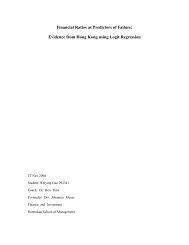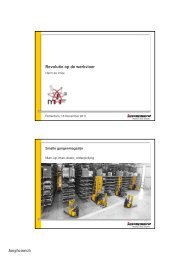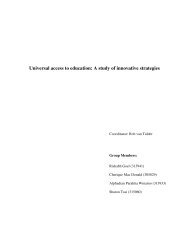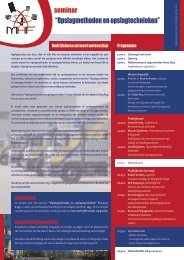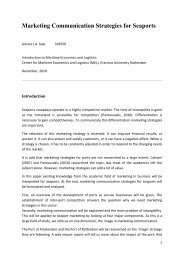Download With great power comes great responsibility (pdf) - ERIM
Download With great power comes great responsibility (pdf) - ERIM
Download With great power comes great responsibility (pdf) - ERIM
Create successful ePaper yourself
Turn your PDF publications into a flip-book with our unique Google optimized e-Paper software.
74<br />
people and the possibilities. A lot of what I will be talking about is going to seem very small scale<br />
compared to what you have seen in terms of Max Havelaar bananas, coffee and tea. But I think my<br />
role here today is to talk about the possibilities of how we make this a little bit bigger, because it is<br />
also an important part of Fair Trade.<br />
The importance of handicrafts<br />
So to begin, I will not assume anything. As a guideline, when I talk about handicrafts I am talking<br />
about something that is made by hand or by simple tools, but not with machinery. It is something that<br />
is not mass-produced in a manufacturing kind of set up. Handicrafts are also something that really has<br />
artistic or cultural influence. This is what I mean when I talk about handicrafts. When it <strong>comes</strong> into<br />
the market perspective, handicrafts is also categorized as what you know as gifts and living and life -<br />
style products. This includes as an example candles, glass, fashion and accessories, household décor,<br />
textiles and a long list of items you use everyday in your household, and that people buy every day in<br />
the supermarket. A lot of these products come from a mass-produced manufacturing set-up, and there<br />
is potential to change some of this and enter into niche markets with handicrafts. But in summary, as a<br />
definition this is what I mean when I talk about handicrafts.<br />
There are a number of reasons why handicrafts are important. I am going to first start with the economic<br />
scope. I have lived in Kenya most of my life, and in my country, as an example, handicrafts are con -<br />
sidered part of what is the informal sector in Africa. Because this sector is considered “informal,”<br />
there is very little support coming to this sector from both governments and from NGOs. A lot of these<br />
bodies prefer to provide their support to the agricultural sector and to the industrial and<br />
manufacturing sector because this is considered formal.<br />
So the informal sector, where handicrafts fit, is something that has been <strong>great</strong>ly ignored, yet it has such<br />
a large contribution to the economic em<strong>power</strong>ment of the continent. For example, in sub-Saharan Africa<br />
the informal sector contributes between 48 and 72 per cent of the gross national income. It is higher<br />
in the countries that have smaller economies or are struggling economically, such as Zimbabwe – which<br />
should have about 72 per cent – and much lower in the stronger economies like South Africa, that will<br />
have about 48 per cent. So imagine that: 48 to 72 per cent of the gross national income is informal<br />
sector, so it should in fact not be ignored.<br />
Second, in terms of employment, it is a fact, particularly in countries in sub-Saharan Africa, that the<br />
informal sector is responsible for close to 60 per cent of employment, and about 80 per cent of new<br />
job creation – particularly in times of economic hardship. When people cannot get work in the formal<br />
sector they always fall back to the informal sector. We find this happens during hard economic<br />
times – that is why Zimbabwe has about 72 per cent contribution to GNI – people fall back on the<br />
informal sector.<br />
If I can speak specifically about two countries in particular: In Kenya the informal sector, which is<br />
known as “jua kali”, contributes between 10 and 20 per cent to the economy. In South Africa it is<br />
10 to 12 per cent of the whole economy of the country. This is quite a big contribution, which should<br />
in fact mean that a lot of support is needed to the information sector. <strong>With</strong> this support how much<br />
more would it contribute to the economies of developing countries. Currently, there is not really any<br />
organization or public office collecting relevant data or statistics regularly to find out how much the<br />
informal sector is contributing to our economy, and how it can be enhance. A lot of the information<br />
that we get, even from the World Bank, even from the ILO is categorized as estimates, and we not able<br />
to give specific information.<br />
Another thing that makes handicrafts very important to Africa is that it is one of the few sectors in<br />
which Africa has a comparative advantage, that is, where we have the <strong>power</strong> to compete. This is for a<br />
number of reasons that I will proceed to explain. Realistically, there are a lot of sectors where Africa is<br />
never going to compete with other regions such as Asia, or other more developed countries and econo -<br />
mies such as China, India, or the U.S among others. I do not imagine that there will come a time when<br />
Kenya will be competing in terms of nuclear energy, to give an example, or in terms of having a satellite<br />
on the moon that increasing communication technology, or studying how Mars can become a new<br />
place for us to live – this is not going to happen.<br />
Em<strong>power</strong>ment through markets<br />
As a continent, we have to look at the sectors where we have a comparative advantage and where we<br />
can successfully compete and become market leaders. And it is a fact that in handicrafts do have a<br />
comparative advantage; firstly because of the unique cultural elements of our products. As I mentioned<br />
earlier, handicrafts are based on our cultural and artistic property. A lot of the large commercial<br />
organizations have started to see that, and I will give you an example. Bogolan is a fabric, or textile,<br />
that <strong>comes</strong> from West Africa – it is similar to what I am wearing today. Nike has in the past designed a<br />
special edition sneaker. Nike a big international brand has seen something that is commercially viable<br />
from African culture and crafts. The company has positioned this special edition bogolan shoe and<br />
are selling this shoe for hundreds of dollars, in large quantities.<br />
On the other hand, the people who are the owners of bogolan, that is the community to which this<br />
cultural item belongs, are they getting a percentage of these sales? Are they getting a benefit from the<br />
exploitation of their cultural property? I think that is the question that we need to ask ourselves. That<br />
is not the only example. A famous fashion designer, the late Alexander McQueen, I think some of you<br />
might know him, showed in one of his collections, about two years ago, a new design, a new fabric, a<br />
new thing that he was going to commercialize, and it was actually based on Ethiopian traditional weaving<br />
skills. And many more cases exist today.<br />
The potential to commercialize and em<strong>power</strong> people through handicraft is very real, because large<br />
companies are starting to see this, and exploit it. And we need to also see this as Fair Traders. I do not<br />
know if you have heard of the Maasai Barefoot Technology shoe, MBT, based on the cultural foot wear<br />
of the Maasai. The Maasai and their culture fascinate many people. One of the things that is <strong>great</strong>ly<br />
admires is how the Maasai stand so tall, they walk very straight and upright, they take long steady<br />
strides. The MBT shoe is based on lessons learnt from the Maasai their culture and how they do things,<br />
and it is selling for hundreds and hundreds of dollars. How can we transform this cultural property<br />
that exists in Africa to help em<strong>power</strong> the communities in Africa? It is something that is really important<br />
– the unique cultural elements. How can Fair Trade take this and work to commercialize it in a<br />
sustainable way that results in the economic em<strong>power</strong>ment of people.<br />
The skills are already exists within Africa – it is something that the communities can already do. We just<br />
need to upgrade the skills, and scale it up into something that be<strong>comes</strong> commercially viable. There is<br />
also the existence of raw materials. The majority of handicraft products are based on materials that<br />
are found in Africa and that are sustainable in our environments. The main thing needed for handi crafts<br />
75





